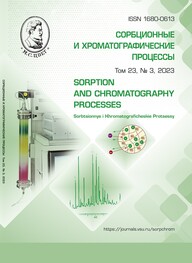The use of magnetic carbons obtained from vegetable raw materials based on rice husks for the extraction of chlorophenoxyacetic acids and their metabolites
Abstract
Carbon sorbents (CS) are one of the most studied and used in various industries (oil and gas, chemical, etc.), they are also effective for extracting and concentrating almost all groups of organic and inorganic compounds. Various organic raw material are the basis for obtaining CS, inexpensive sorption materials obtained from natural materials. Their advantages include abundance, availability, low cost, high sorption capacity. One of the modern areas of concentration technology is the use of "core-shell” magnetic sorbents.
The purpose of the study was the possibility of obtaining a magnetic adsorbent based on natural material - rice husk (RH) and further application for the extraction of chlorophenoxyacetic acids [2,4-dichlorophenoxyacetic (2,4-D), 2,4-dichlorophenoxybutyric (2,4- DM), 2,4-dichlorophenoxypropionic (2,4-DP)] and their metabolites [2,4-dichlorophenol (2,4-DCP) or 4-chlorophenol (4-CP)].
A method for the synthesis of magnetic coal (Fe3O4/C) from RH, waste of plant origin was suggested. The synthesis includes burning at 600ºС, grinding in a planetary mill and mixing the resulting coal in solution with FeCl3 and FeSO4 in an alkaline medium at a temperature of 70ºС. Dimensions of the magnetic core Fe3O4/C were 8 – 22 nm, particle sizes were from 0.5 to 3 µm. The specific surface area of the adsorbent was 892 m2/g, pore volume was 0.2945 cm3/g, the average pore size was 2.24 nm.
Synthesized Fe3O4/C showed high efficiency in relation to chlorophenoxyacetic acids and chlorophenols. Optimal sorption conditions were established: adsorbent dose - 2 g/dm3, pH 3 (the degree of extraction depends on the surface charge of the adsorbent and sorbate), adsorption time was 3–5 min. The recovery rates were 87.5 – 99.9%. Under such conditions, sorption isotherms were obtained and the sorption capacity of the studied adsorbent with respect to sorbates was evaluated. Sorption isotherms were processed using the Langmuir and Freundlich equations. The highest correlation coefficients (r2 = 0.987-0.993) were established when they were presented in Langmuir coordinates, the maximum adsorption capacity of 2,4-D, 2,4-DP, 2,4-DM, 2,4-DCP, 4-CP was 318.1, 352.2, respectively, 382.5, 512.2, 482.5 mg/g.







